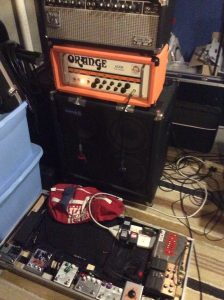Poorly pictured below is my Sunn 4×10 cab, which I’ve re-wired for stereo in order to play both of my Mars Lights amps through it. (This way I don’t have to haul the Music Man’s cabinet to gigs. This may also work for h&s, Sneaky Sneaky Snakes, etc.; any situation where I’m using the GK pickup on my guitar.)

I want the cab’s speakers to all be in phase (all pushing or all pulling simultaneously, not one side pushing while the other side pulls). Sometimes pedals change the phase via latency, or flip its polarity* 180 degrees, so yesterday I tested all of my pedals to see what’s good to use when both amps are running through the Sunn cab. “Good,” in this case, means the pedal does not flip polarity in either bypassed or engaged mode.
* Polarity is whether, starting from silence, the first half-cycle of the sound wave is positive (pushes the speaker) or negative (pulls)
It felt a bit like making molar solutions in chemistry class; for whatever reason, the straightforward task doesn’t mesh with the normally-strong intuitive area of my brain, and completing it is a real challenge.
The whole process was a bit of overkill. There’s less of a phase relationship than I expected between the octave separation between the signals, the different distortion in each signal path, and the latency of the octave down signal. Still, the whole rig sounds slightly better (again, less than I expected but noticeable) when the polarity matches.
Results are that for most pedals, 80-85%, input and output polarity match and I can use them indiscriminately. (In retrospect, this is a good engineering practice generally.) I didn’t find any that change polarity in bypass mode. A handful change polarity when engaged; something like a one-transistor (MXR Micro Amp, Rangemasters, etc.) or three-transistor (Tone Bender family) is just going to do that in their normal configuration (each transistor gain stage flips the polarity of the signal) unless the engineer adds an amplifier stage to flip it back.
But because the rig as a whole needs one polarity flip to sound its best, I want to find an always-on polarity-flipping pedal for one of the signal paths. I have a couple candidates – my Falcon Heavy prototype’s second channel, a Basic Audio Scarab Deluxe fuzz – or I could build a simple high-headroom unity-gain single-JFET pedal for this specific use case. Probably would not have any controls or even a footswitch; just in and out jacks and power input. I plug it in, it does its thing.
I will probably do this. Maybe even today. Ack, I guess I need to prep a box first. Maybe I’ll do *that* today.
tl;dr – Bunch of pedal-geeky stuff, now I don’t have to haul a 2nd cab to Mars Lights and other gigs where I’m using my octave-down guitar thing, spent a few hours working on stuff only recording engineers will notice.
